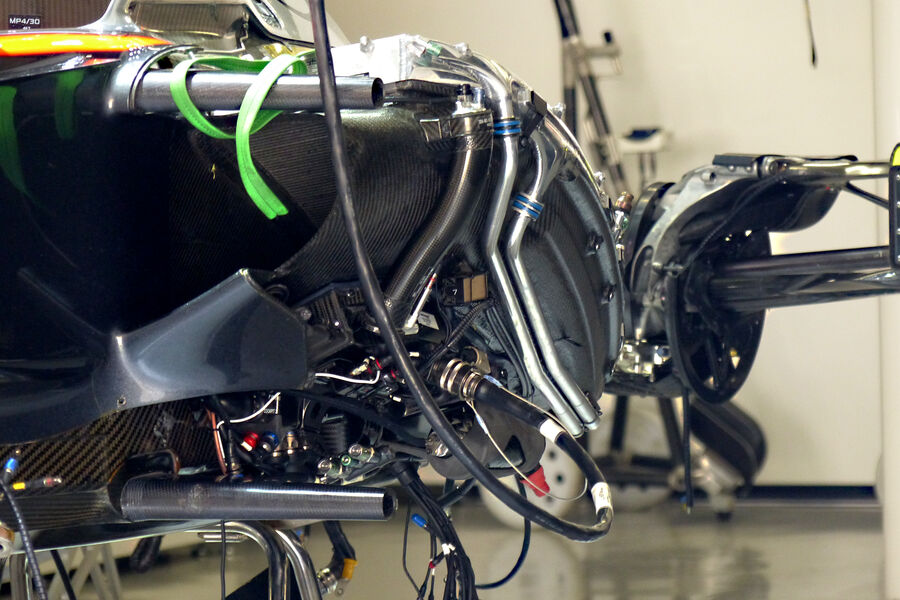







#aerogollumturbof1 wrote: YOU SHALL NOT......STALLLLL!!!

lotus7 wrote:I have been trying to get my head around the mechanical setup/makeup of the DRS activator . Having now seen this "offset" version of Mclaren, I am even more confused
Anyone on here that can enlighten me ? Is it cables , levers , servos inside the housing ?
 This is from Scarbs website showing one potential design. All teams use a hydraulic pulley to open and close the flap.
This is from Scarbs website showing one potential design. All teams use a hydraulic pulley to open and close the flap.You would have thought by now they could integrate this hydrolic system well enough into the end plates. I would want to get rid of that central pillar as quickly as I could, but most teams seem content.JDC123 wrote:http://scarbsf1.com/blog1/wp-content/up ... 00x211.jpg This is from Scarbs website showing one potential design. All teams use a hydraulic pulley to open and close the flap.lotus7 wrote:I have been trying to get my head around the mechanical setup/makeup of the DRS activator . Having now seen this "offset" version of Mclaren, I am even more confused
Anyone on here that can enlighten me ? Is it cables , levers , servos inside the housing ?
shady wrote:You would have thought by now they could integrate this hydrolic system well enough into the end plates. I would want to get rid of that central pillar as quickly as I could, but most teams seem content.JDC123 wrote:http://scarbsf1.com/blog1/wp-content/up ... 00x211.jpg This is from Scarbs website showing one potential design. All teams use a hydraulic pulley to open and close the flap.lotus7 wrote:I have been trying to get my head around the mechanical setup/makeup of the DRS activator . Having now seen this "offset" version of Mclaren, I am even more confused
Anyone on here that can enlighten me ? Is it cables , levers , servos inside the housing ?


trinidefender wrote:shady wrote: You would have thought by now they could integrate this hydrolic system well enough into the end plates. I would want to get rid of that central pillar as quickly as I could, but most teams seem content.
If you followed f1 2013 and previously then you will notice that teams have not run central wing support in years. Before much of the support for the endplates and thus the rear wing came from the beam wing. From 2014 onwards the beam wing was removed. The small space on the floor that the end plates sit on is not large enough to support the weight of wing plus the downforce it generates without the beam wing. The vertical support is there to provide the additional support to the wing that used to be provided by the beam wing.



trinidefender wrote: You would have thought by now they could integrate this hydrolic system well enough into the end plates. I would want to get rid of that central pillar as quickly as I could, but most teams seem content.
I think it may be because of simplicity. It is easier to reach and fix (though not in race as you would loose huge amount of time) this one central actuator then if actuators were in endplates. Also, weight could be another reason because here you have only one actuator acting centrally on the flap, while you would need two of them for same performance if they were in endplates.shady wrote:Im aware, MBAMG seems like theyd have the materials guys who are capable without having that kind of disturbance (namely when the car is turning) holding the wing up. However, I should have been clearer, in that the DRS arm as well should be integrated in the RWEP.. I dont understand why no one has even ventured off the farm in this respect.

I meant the 3 vertical tubes along the lateral aspect of the sidepod. One made of carbon fiber, the other two metallic.Moose wrote:If you're referring to the horizontal tubes, those are the crash structure, and no, you can't save weight there - they're a mandated design.captainmorgan wrote:Could those tubes be integrated into the carbon fiber to save weight?Thunders wrote:First Pictures from China by AMuS:
http://img3.auto-motor-und-sport.de/McL ... 855651.jpg
Do you mean this picture?captainmorgan wrote:
I meant the 3 vertical tubes along the lateral aspect of the sidepod. One made of carbon fiber, the other two metallic.
